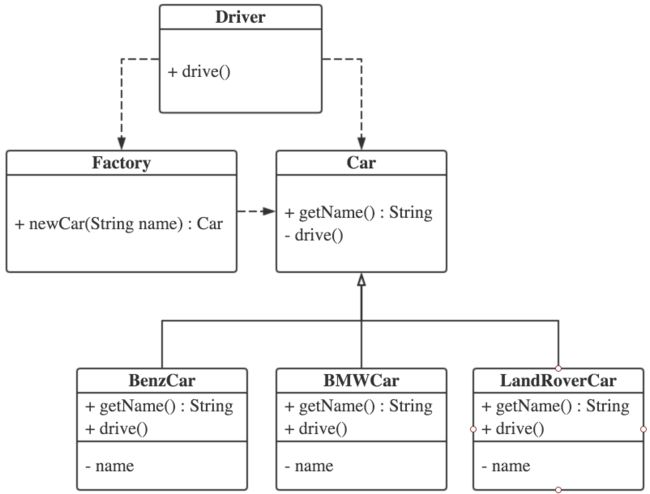Java设计模式(一) 简单工厂模式不简单
原创文章,转载请务必将下面这段话置于文章开头处。
本文转发自Jason’s Blog,原文链接 http://www.jasongj.com/design_pattern/simple_factory
简单工厂模式使用案例
有一种抽象产品——汽车(Car),同时有多种具体的子类产品,如BenzCar,BMWCar,LandRoverCar。类图如下
作为司机,如果要开其中一种车,比如BenzCar,最直接的做法是直接创建BenzCar的实例,并执行其drive方法,如下
package com.jasongj.client;
import com.jasongj.product.BenzCar;
public class Driver1 {
public static void main(String[] args) {
BenzCar car = new BenzCar();
car.drive();
}
}此时如果要改为开Land Rover,则需要修改代码,创建Land Rover的实例并执行其drive方法。这也就意味着任何时候需要换一辆车开的时候,都必须修改客户端代码。
一种稍微好点的方法是,通过读取配置文件,获取需要开的车,然后创建相应的实例并由父类Car的引用指向它,利用多态执行不同车的drive方法。如下
package com.jasongj.client;
import org.apache.commons.configuration.ConfigurationException;
import org.apache.commons.configuration.XMLConfiguration;
import org.slf4j.Logger;
import org.slf4j.LoggerFactory;
import com.jasongj.product.BMWCar;
import com.jasongj.product.BenzCar;
import com.jasongj.product.Car;
import com.jasongj.product.LandRoverCar;
public class Driver2 {
private static final Logger LOG = LoggerFactory.getLogger(Driver2.class);
public static void main(String[] args) throws ConfigurationException {
XMLConfiguration config = new XMLConfiguration("car.xml");
String name = config.getString("driver2.name");
Car car;
switch (name) {
case "Land Rover":
car = new LandRoverCar();
break;
case "BMW":
car = new BMWCar();
break;
case "Benz":
car = new BenzCar();
break;
default:
car = null;
break;
}
LOG.info("Created car name is {}", name);
car.drive();
}
}对于Car的使用方而言,只需要通过参数即可指定所需要Car的各类并得到其实例,同时无论使用哪种Car,都不需要修改后续对Car的操作。至此,简单工厂模式的原型已经形成。如果把上述的逻辑判断封装到一个专门的类的静态方法中,则实现了简单工厂模式。工厂代码如下
package com.jasongj.factory;
import org.apache.commons.configuration.ConfigurationException;
import org.apache.commons.configuration.XMLConfiguration;
import org.slf4j.Logger;
import org.slf4j.LoggerFactory;
import com.jasongj.product.BMWCar;
import com.jasongj.product.BenzCar;
import com.jasongj.product.Car;
import com.jasongj.product.LandRoverCar;
public class CarFactory1 {
private static final Logger LOG = LoggerFactory.getLogger(CarFactory1.class);
public static Car newCar() {
Car car = null;
String name = null;
try {
XMLConfiguration config = new XMLConfiguration("car.xml");
name = config.getString("factory1.name");
} catch (ConfigurationException ex) {
LOG.error("parse xml configuration file failed", ex);
}
switch (name) {
case "Land Rover":
car = new LandRoverCar();
break;
case "BMW":
car = new BMWCar();
break;
case "Benz":
car = new BenzCar();
break;
default:
car = null;
break;
}
LOG.info("Created car name is {}", name);
return car;
}
}调用方代码如下
package com.jasongj.client;
import com.jasongj.factory.CarFactory1;
import com.jasongj.product.Car;
public class Driver3 {
public static void main(String[] args) {
Car car = CarFactory1.newCar();
car.drive();
}
}与Driver2相比,所有的判断逻辑都封装在工厂(CarFactory1)当中,Driver3不再需要关心Car的实例化,实现了对象的创建和使用的隔离。
当然,简单工厂模式并不要求一定要读配置文件来决定实例化哪个类,可以把参数作为工厂静态方法的参数传入。
简单工厂模式进阶
使用反射实现扩展性
从Driver2和CarFactory1的实现中可以看到,当有新的车加入时,需要更新Driver2和CarFactory1的代码也实现对新车的支持。这就违反了开闭原则(Open-Close Principle)。可以利用反射(Reflection)解决该问题。
package com.jasongj.factory;
import org.apache.commons.configuration.ConfigurationException;
import org.apache.commons.configuration.XMLConfiguration;
import org.slf4j.Logger;
import org.slf4j.LoggerFactory;
import com.jasongj.product.Car;
public class CarFactory2 {
private static final Logger LOG = LoggerFactory.getLogger(CarFactory2.class);
public static Car newCar() {
Car car = null;
String name = null;
try {
XMLConfiguration config = new XMLConfiguration("car.xml");
name = config.getString("factory2.class");
} catch (ConfigurationException ex) {
LOG.error("Parsing xml configuration file failed", ex);
}
try {
car = (Car)Class.forName(name).newInstance();
LOG.info("Created car class name is {}", name);
} catch (InstantiationException | IllegalAccessException | ClassNotFoundException e) {
LOG.error("Instantiate car {} failed", name);
}
return car;
}
}从上面代码中可以看到,之后如果需要引入新的Car,只需要在配置文件中指定该Car的完整类名(包括package名),CarFactory2即可通过反射将其实例化。实现了对扩展的开放,同时保证了对修改的关闭。熟悉Spring的读者应该会想到Spring IoC的实现。
注解让简单工厂模式不简单
上例中使用反射做到了对扩展开放,对修改关闭。但有些时候,使用类的全名不太方便,使用别名会更合适。例如Spring中每个Bean都会有个ID,引用Bean时也会通过ID去引用。像Apache Nifi这样的数据流工具,在流程上使用了职责链模式,而对于单个Processor的创建则使用了工厂,对于用户自定义的Processor并不需要通过代码去注册,而是使用注解(为了更方便理解下面这段代码,请先阅读笔者另外一篇文章《Java系列(一)Annotation(注解)》)。
下面就继续在上文案例的基础上使用注解升级简单工厂模式。
package com.jasongj.factory;
import java.util.Collections;
import java.util.Map;
import java.util.Set;
import java.util.concurrent.ConcurrentHashMap;
import org.apache.commons.configuration.ConfigurationException;
import org.apache.commons.configuration.XMLConfiguration;
import org.reflections.Reflections;
import org.slf4j.Logger;
import org.slf4j.LoggerFactory;
import com.jasongj.annotation.Vehicle;
import com.jasongj.product.Car;
public class CarFactory3 {
private static final Logger LOG = LoggerFactory.getLogger(CarFactory3.class);
private static Map<String, Class> allCars;
static {
Reflections reflections = new Reflections("com.jasongj.product");
Set<Class<?>> annotatedClasses = reflections.getTypesAnnotatedWith(Vehicle.class);
allCars = new ConcurrentHashMap<String, Class>();
for (Class<?> classObject : annotatedClasses) {
Vehicle vehicle = (Vehicle) classObject.getAnnotation(Vehicle.class);
allCars.put(vehicle.type(), classObject);
}
allCars = Collections.unmodifiableMap(allCars);
}
public static Car newCar() {
Car car = null;
String type = null;
try {
XMLConfiguration config = new XMLConfiguration("car.xml");
type = config.getString("factory3.type");
LOG.info("car type is {}", type);
} catch (ConfigurationException ex) {
LOG.error("Parsing xml configuration file failed", ex);
}
if (allCars.containsKey(type)) {
LOG.info("created car type is {}", type);
try {
car = (Car) allCars.get(type).newInstance();
} catch (InstantiationException | IllegalAccessException ex) {
LOG.error("Instantiate car failed", ex);
}
} else {
LOG.error("specified car type {} does not exist", type);
}
return car;
}
}从上面代码中可以看到,该工厂会扫描所有被Vehicle注解的Car(每种Car都在注解中声明了自己的type,可作为该种Car的别名)然后建立起Car别名与具体Car的Class原映射。此时工厂的静态方法即可根据目标别名实例化对应的Car。
本文所有代码都可从作者GitHub下载.
简单工厂模式详解
简单工厂模式定义
简单工厂模式(Simple Factory Pattern)又叫静态工厂方法模式(Static FactoryMethod Pattern)。专门定义一个类(如上文中的CarFactory1、CarFactory2、CarFactory3)来负责创建其它类的实例,由它来决定实例化哪个具体类,从而避免了在客户端代码中显式指定,实现了解耦。该类由于可以创建同一抽象类(或接口)下的不同子类对象,就像一个工厂一样,因此被称为工厂类。
简单工厂模式类图
简单工厂模式角色划分
- 工厂角色(如上文中的CarFactory1/2/3):这是简单工厂模式的核心,由它负责创建所有的类的内部逻辑。当然工厂类必须能够被外界调用,创建所需要的产品对象。一般而言,工厂类提供一个静态方法,外部程序通过该方法创建所需对象。
- 抽象产品角色(如上文中的Car):简单工厂模式所创建的所有对象的父类。注意,这里的父类可以是接口也可以是抽象类,它负责描述所创建实例共有的公共接口。
- 具体产品角色(如上文中的BMWCar,BenzCar,LandRoverCar):简单工厂所创建的具体实例对象,这些具体的产品往往都拥有共同的父类。
简单工厂模式优点
- 工厂类是整个简单工厂模式的关键所在。它包含必要的判断逻辑,能够根据外界给定的信息(配置,或者参数),决定究竟应该创建哪个具体类的对象。用户在使用时可以直接根据工厂类去创建所需的实例,而无需了解这些对象是如何创建以及如何组织的。有利于整个软件体系结构的优化。
- 通过引入配置文件和反射,可以在不修改任何客户端代码的情况下更换和增加新的具体产品类,在一定程度上提高了系统的灵活性(如CarFactory2)。
- 客户端无须知道所创建的具体产品类的类名,只需要知道具体产品类所对应的参数即可,对于一些复杂的类名,通过简单工厂模式可以减少使用者的记忆量(如CarFactory3)。
简单工厂模式与OOP原则
已遵循的原则
- 依赖倒置原则
- 迪米特法则
- 里氏替换原则
- 接口隔离原则
未遵循的原则
- 开闭原则(如上文所述,利用配置文件+反射或者注解可以避免这一点)
- 单一职责原则(工厂类即要负责逻辑判断又要负责实例创建)
简单工厂模式缺点
- 由于工厂类集中了所有实例的创建逻辑,这就直接导致一旦这个工厂出了问题,所有的客户端都会受到牵连。
- 由于简单工厂模式的产品是基于一个共同的抽象类或者接口,这样一来,产品的种类增加的时候,即有不同的产品接口或者抽象类的时候,工厂类就需要判断何时创建何种接口的产品,这就和创建何种种类的产品相互混淆在了一起,违背了单一职责原则,导致系统丧失灵活性和可维护性。
- 正如上文提到的,一般情况下(如CarFactory1),简单工厂模式违背了“开放-关闭原则”,因为当我们新增加一个产品的时候必须修改工厂类,相应的工厂类就需要重新编译一遍。但这一点可以利用反射(CarFactory3在本质上也是利用反射)在一定程度上解决(如CarFactory2)。
- 简单工厂模式由于使用了静态工厂方法,造成工厂角色无法形成基于继承的等级结构。这一点笔者持保留态度,因为继承不是目的,如果没有这样的需求,这一点完全不算缺点,例如JDBC的DriverManager。
简单工厂模式在JDK中的典型应用
简单工厂模式在JDK中最典型的应用要数JDBC了。可以把关系型数据库认为是一种抽象产品,各厂商提供的具体关系型数据库(MySQL,PostgreSQL,Oracle)则是具体产品。DriverManager是工厂类。应用程序通过JDBC接口使用关系型数据库时,并不需要关心具体使用的是哪种数据库,而直接使用DriverManager的静态方法去得到该数据库的Connection。
package com.jasongj.client;
import java.sql.Connection;
import java.sql.DriverManager;
import java.sql.PreparedStatement;
import java.sql.SQLException;
import org.slf4j.Logger;
import org.slf4j.LoggerFactory;
public class JDBC {
private static final Logger LOG = LoggerFactory.getLogger(JDBC.class);
public static void main(String[] args) {
Connection conn = null;
try {
Class.forName("org.apache.hive.jdbc.HiveDriver");
conn = DriverManager.getConnection("jdbc:hive2://127.0.0.1:10000/default");
PreparedStatement ps = conn.prepareStatement("select count(*) from test.test");
ps.execute();
} catch (SQLException ex) {
LOG.warn("Execute query failed", ex);
} catch(ClassNotFoundException e) {
LOG.warn("Load Hive driver failed", e);
} finally {
if(conn != null ){
try {
conn.close();
} catch (SQLException e) {
// NO-OPT
}
}
}
}
}Java设计模式系列
- Java设计模式(一) 简单工厂模式不简单
- Java设计模式(二) 工厂方法模式
- Java设计模式(三) 抽象工厂模式
- Java设计模式(四) 观察者模式
